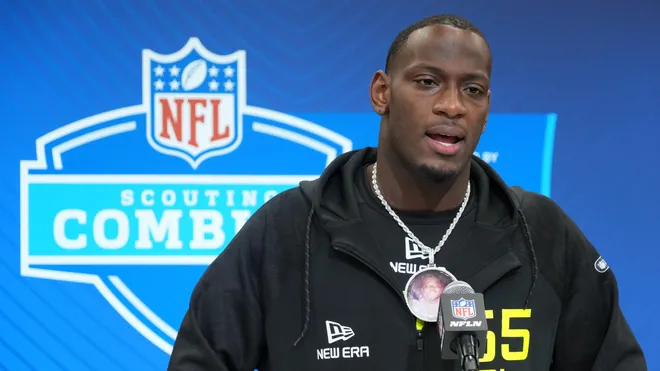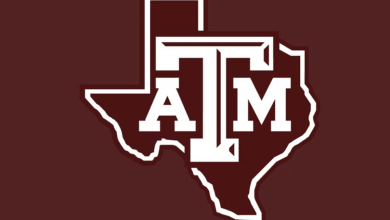Texas A\&M coach Mike Elko confirms Shemar Stewart will not return for the 2025 season, impacting the Aggies’ defensive plans and roster depth.

Texas A&M football head coach Mike Elko has officially confirmed that Shemar Stewart, one of the program’s highly regarded defensive line prospects, will not be returning to the Aggies for the 2025 season. This announcement ends months of speculation regarding Stewart’s collegiate future and poses significant implications for Texas A&M’s defensive strategy and roster management moving forward.
Stewart’s decision not to return forces the Aggies’ coaching staff to reassess their defensive line depth and develop contingency plans for a competitive Southeastern Conference (SEC) campaign. This article explores the background of Shemar Stewart’s recruitment and development, analyzes the impact of his absence on Texas A&M’s defense, and discusses how the Aggies can adapt to maintain their competitive edge in one of college football’s toughest conferences.
Who is Shemar Stewart? The Defensive End with High Expectations
To understand the full impact of Stewart’s departure, it is important to review who he is and the promise he represented for the Aggies.
Early Promise and Recruitment
Shemar Stewart came into college football as one of the most highly touted defensive end recruits in the nation. Known for his imposing size — standing around 6-foot-6 and weighing well over 270 pounds — combined with exceptional athleticism, Stewart’s physical tools made him an immediate threat on the defensive front.
Coming out of high school, Stewart was a consensus five-star recruit and ranked among the top defensive end prospects in the country. His recruitment drew attention from powerhouse programs across the nation, but Texas A&M’s successful recruitment of Stewart was viewed as a major win for the Aggies, promising to bolster their defensive line for years to come.
The Path and Speculation Around Stewart’s Future
Despite the high expectations surrounding Stewart’s arrival at Texas A&M, his collegiate tenure has been shrouded in uncertainty.
Initial Integration and Development
Stewart’s first year with the Aggies was marked by a period of acclimation to the college game — adjusting to the speed, complexity, and physicality of SEC competition. While Stewart demonstrated flashes of potential in practice and limited game action, questions remained about how quickly he would become a dominant presence on the field.
Ongoing Speculation
Rumors and speculation about Stewart’s status surfaced intermittently throughout his time at Texas A&M. Reports suggested that Stewart might be considering transfer options or sitting out future seasons, which created uncertainty among fans and coaches about his role in the program’s future.
Mike Elko’s Confirmation: Stewart Not Returning for 2025 Season
In a recent press conference, head coach Mike Elko addressed the swirling rumors directly, confirming that Shemar Stewart will not be returning to Texas A&M for the 2025 football season. Elko’s statement made clear that while Stewart remains an important part of Aggie football history, he will not contribute on the field next season.
While Elko did not elaborate extensively on the reasons behind Stewart’s decision, his remarks suggested that the focus for the coaching staff now shifts fully to developing the players currently committed and available for the upcoming season.
Immediate Impact on Texas A&M’s Defensive Line
Stewart’s departure leaves a significant hole in the Aggies’ defensive line plans, affecting both depth and long-term development.
Loss of Elite Physical Talent
Stewart’s size, strength, and potential pass-rushing ability made him a valuable asset expected to contribute to the Aggies’ defensive front. His absence means the team loses an imposing physical presence capable of disrupting opposing offenses.
Increased Pressure on Current Defensive Linemen
Without Stewart, current defensive linemen must step up to fill the gap. Players who were expected to play supporting roles may now be called on to carry heavier workloads, and younger prospects will need accelerated development to meet the demands of SEC competition.
Adjustments in Defensive Schemes
Coaching staff may need to tweak defensive schemes and rotations to account for the reduced depth and altered skill set of the defensive line. This could mean increased use of blitz packages, reliance on linebackers for pass rush, or adjustments to gap assignments to compensate.
Broader Implications for the Texas A&M Football Program
Stewart’s absence extends beyond immediate roster considerations, influencing recruiting, player development, and program culture.
Recruiting Strategy Adjustments
The Aggies may intensify their efforts in the defensive line recruiting class for the next cycles to replace the lost talent. This could include aggressive pursuit of five-star defensive ends or leveraging the transfer portal to add experienced players who can contribute immediately.
Focus on Player Retention and Development
The situation highlights the importance of retaining talent and developing players within the program. Texas A&M may expand support structures — including coaching, mentoring, and academic assistance — to ensure current players stay engaged and grow into leadership roles.
Maintaining Team Morale and Culture
Loss of a highly recruited player can impact team morale, especially among defensive players who anticipated Stewart’s presence. However, the coaching staff can use this as an opportunity to emphasize resilience, teamwork, and a “next man up” mentality, rallying players to collectively overcome challenges.
What’s Next for Shemar Stewart?
Though Stewart will not return to Texas A&M for the 2025 season, his future remains open in college football and beyond.
Potential Transfer Opportunities
It is common for high-profile recruits in similar situations to explore transfers. Stewart may seek a new program that better aligns with his goals, playing style, or personal circumstances. The NCAA transfer portal provides opportunities to continue his career elsewhere.
Preparing for Professional Prospects
Given Stewart’s physical tools and early potential, he may also consider focusing on training for professional opportunities, whether through further collegiate play at a different school or entering the NFL Draft after demonstrating readiness.
How Texas A&M Can Adapt and Thrive
Despite the setback of losing a talented player like Stewart, Texas A&M possesses several strengths that can help the program maintain competitiveness.
Developing Depth and Talent
Aggies coaching staff can invest in developing depth on the defensive line, emphasizing strength and conditioning programs, technical skill development, and mental preparation to elevate the entire unit.
Utilizing the Transfer Portal
Texas A&M can leverage the transfer portal strategically, recruiting experienced defensive linemen who can contribute immediately and provide leadership on the defensive front.
Emphasizing Team Chemistry
A focus on building chemistry and accountability among current players can foster a cohesive defensive unit capable of executing complex game plans effectively.
A Challenge and an Opportunity for Texas A&M Football
The confirmation by head coach Mike Elko that Shemar Stewart will not return for the 2025 season marks a pivotal moment for Texas A&M football. While the loss of such a promising defensive talent presents challenges in terms of depth and defensive strategy, it also offers an opportunity for the program to adapt, innovate, and rally around its remaining players.
Through strategic recruiting, player development, and a focus on resilience and teamwork, Texas A&M can overcome this setback and continue its pursuit of excellence in the highly competitive SEC.
For Shemar Stewart, the next chapter remains unwritten, with possibilities ranging from transferring to another program to preparing for a professional career. For Texas A&M, the focus will be on maximizing the talent on hand and building a defense capable of standing strong without one of its once-anticipated stars.
As the Aggies prepare for the 2025 season, fans and analysts alike will watch closely to see how the team navigates this transition and continues to compete at the highest levels of college football.









